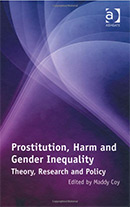Prostitution, Harm, and Gender Inequality:
Theory, Research and Policy
 Author: Maddy Coy, ed.
Author: Maddy Coy, ed.
Publisher: Farnham, Surrey, UK; Burlington, VT: Ashgate Publishing, 2012. 207p.
Reviewer: Annette Jolin | January 2013
This anthology brings together writings by academics, researchers, activist/practitioners, and graduate students from Great Britain, Australia, Finland, Sweden, and the United States. It highlights the flaws inherent in conceptualizing prostitution as sex-work. This conceptualization, as several contributors point out, is favored by neo-liberal feminists who believe that prostitution can be empowering to some women and may represent rational choice in a market environment. The authors uniformly reject this idea. Linking prostitution to choice and empowerment, they argue, obscures the debilitating physical and psychological problems that prostitutes experience.
Practices adopted to normalize prostitution in the eyes of the population began in the 1990s. They have helped to popularize, and maybe even glamourize prostitution, thus exposing growing numbers of women to the detrimental effects of the sex industry. The film Pretty Woman is cited as but one example of how the stigma associated with prostitution can be transformed into something the authors call “prostitution chic.” Technology, global capitalism, and wide-spread expansion as well as mainstream acceptance solidify prostitution’s consumer good status. In Marjut Jyrkinen’s chapter, this development is called “McSexualization,” a calculating process that encourages mass consumption and bestows legitimacy, but also obscures the power inequalities that account for the existence of prostitution in the first place. In its entirety, the book makes an impassioned case for the reader to embrace the notion that prostitution is a “harmful model of sex” under any circumstances. There is no such thing as voluntary prostitution or prostitution that is free of harm.
The authors adopt the traditional “male buyer female supplier” heterosexual definition of prostitution. While noting the existence of a variety of types of prostitution, the majority of the chapters address street, brothel, and strip-club prostitution. This is not a surprise. These are the most visible forms of prostitution and also the ones most accessible to be studied by scholars and activists. Only under unusual circumstances, such as those involving former New York Governor Eliot Spitzer or the former head of the International Monetary Fund Dominique Strauss-Kahn, do we get glimpses of upper-class escort prostitution. Sexual services at this level are predicated on discretion and low visibility. Consequently we know less about some prostitutes and more about others. For scholars this poses difficulties. Does one produce a piece of writing with endless disclaimers, or does one forge ahead with the information that is available and trust the reader to discern its inherent limitations? How such problems are resolved may depend in part on how strongly authors are invested in advancing a certain point of view. In this book two messages are presented with conviction: One, that all prostitution is harmful to individual prostitutes; and two, that the existence of prostitution is harmful to women in general.
Can the case for “harm to all prostitutes” be made convincingly on the basis of information derived from some? Probably, but we can’t be sure. The available data leave little doubt that the most vulnerable women—women with childhood abuse histories, financially and educationally disadvantaged women, women with substance abuse problems, and trafficked women—experience greater harms than women who don’t sell sex. But what about the more privileged woman who sells sex to wealthy or prominent men to pay for law school? What harms does she experience? Despite the comparable lack of data, the book suggests that she too will be harmed because prostitution is by definition an act of violence. But what if the benefits of an advanced professional degree, freedom from debt, and a future career outweigh experiences of de-humanization, objectification, and stigmatization? This question comes awfully close to viewing prostitution as sex-work, a view the writings in this book soundly reject and hold responsible for many of the excesses and harms associated with the sex industry as it currently exists.
The book’s second core message — that prostitution is harmful to women in general and not only to those with connections to the sex industry — is articulated by several authors. In the final chapter, Maddy Coy, the book’s editor and major contributor, argues that all women are diminished if we accept the idea that the sexualization and objectification of women’s bodies as commodities constitutes empowerment. Glamourizing the de-humanization that is inherent in men purchasing women for sex ensures the continued existence of gender inequalities both inside and outside of the sex industry. Gender inequality means diminished status vis-à-vis men materially and psychologically. It puts women at risk for poverty, ill health, and yes, abuse, exploitation and coercion — words often associated with prostitution. It is in this broad sense that Coy and several of the other authors describe prostitution as both “cause and consequence” of inequality.
This book is not heavily burdened by statistics or empirical policy analyses. Of the three data-based contributions, the most interesting one examines how men account for their involvement in prostitution. Telephone interviews with 105 men, recruited through advertisements in London area newspapers, revealed that more than ninety percent viewed the transaction in strictly economic terms. As they saw it, they paid to have their sexual needs met and the money they paid met the financial needs of the women who provided them with sex—clearly a win-win situation, in the opinion of the men. But the data also showed that not all men were without misgivings. Over one fifth of the sample voiced varying degrees of ambivalence about their encounters with prostitutes. Expressions of guilt and shame, the author notes, can be a starting point for interventions that lead to a reduced demand for prostitution. Yet what form such interventions might take and how they could be used to augment other policy approaches is left open; a small point, perhaps, but one that is indicative of the book’s main weakness—its handling of prostitution policy. While there is no lack of criticisms leveled at current prostitution policies, there is an almost complete absence of constructive input. This is disappointing because the authors do a good job convincing the reader of the urgent need for effective solutions. Rather than offering some, however, they retreat from the task. Instead, they concentrate on criticizing neo-liberal feminists whose sex-work approach is viewed as playing into the hands of the sex-industry’s efforts to normalize prostitution. In this sense the book is testimony to the multi-layered conflicts this topic always elicits. Still, the authors’ overall message is not lost. De-stigmatizing or normalizing processes that obscure the debilitating physical and psychological consequences of prostitution do women no favor, especially as more and more of them will be swept up by the growth of a powerful industry increasingly fueled by new technologies and global reach.
Annette Jolin is Professor Emerita at the Division of Criminology and Criminal Justice, Portland State University.


